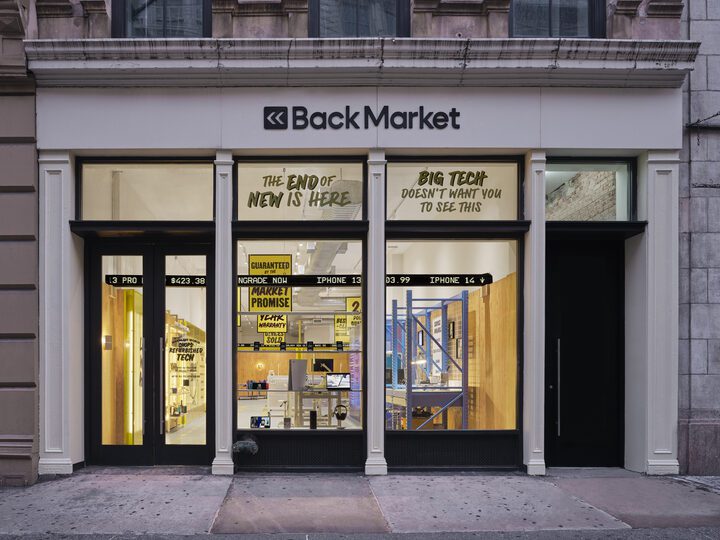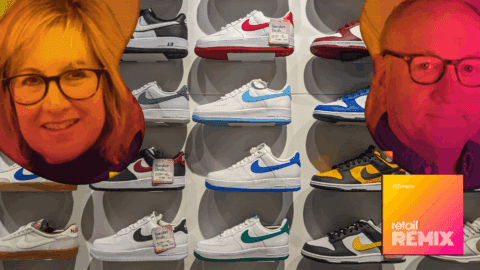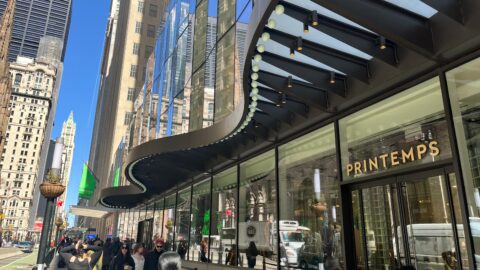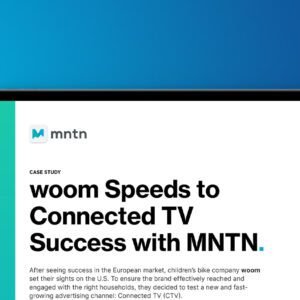Fast fashion is now a term familiar to most consumers, but similar “buy-it-and-toss-it” mentalities pervade many other categories as well, with far less discussion around the environmental and human impact.
In 2014 refurbished electronics marketplace Back Market set out to change this cycle, which it has dubbed “fast tech.” Now, the online platform is bringing its mission of encouraging consumers to “buy smarter, not newer” to the streets of New York City, with a wide-reaching OOH campaign and temporary store in SoHo.
“We could cover the island of Manhattan in Eiffel Towers of e-waste every single year; it’s staggering,” said Lauren Benton, U.S. General Manager for Back Market, a certified B Corp since 2023, in an interview with Retail TouchPoints. “[Advocates against]fast fashion have done a really good job — people understand that whatever item is hot this season is going to be made cheaply and then we’re going to dispose of it. But customers don’t know that about tech.
“They don’t step back [and consider] where the cobalt that’s in every single battery is being mined and the atrocities that happen [in those places], yet all of our electronics require it,” she added. “It’s not just about how you replace the battery, because a battery’s a battery. It’s about doing more with what we have and keeping [these devices in circulation] for longer. It’s about maintaining our electronics so that we can delay the drain on the finite resources of this planet.”
Not Your Typical Tech Store
After expanding online to 17 global markets over the last 10 years and selling more than 30 million devices, Back Market decided the next step was to give customers hands-on access to the quality and benefits of refurbished electronics. The company’s first brick-and-mortar store, developed in partnership with creative agency Mythology, opened in New York City’s SoHo neighborhood last week for a three-month run that will end on Dec. 21.
Designed to be a real-world introduction to Back Market’s offering and mission, New York was the perfect location to make that case, according to Benton. The store’s opening builds on a “cheeky” out-of-home campaign across the NYC subway system, encouraging New Yorkers to downgrade their devices.
“New York is a cultural center and retail hub of the world, but it’s also a city of really curious, diverse people [who are] forward about their feedback,” explained Benton. “This is an opportunity for us to engage with and learn from these customers, to inform [how we can perpetuate] that change-driving behavior that we want to have at a national level.
“The store is right near [the intersection of] Broadway and Canal, where you’ve got so many local New Yorkers but also a lot of tourists,” Benton added. “In this one spot, we get to touch and speak to so many people, so the next three months for us are an ongoing customer focus group to help us learn how to speak to America better about the opportunity to adopt refurbished tech.”
Tariffs Open Consumers to the Idea of Refurbished Tech
The timing couldn’t be better. Given tech’s omnipresent utility in our lives, it’s perhaps understandable that many consumers turn a blind eye to the waste that results from “upgrade culture.” But other forces are bringing the problems of “fast tech” to the forefront for consumers — conversations around global trade that have been prompted by tariffs, not to mention the resulting price increases; growing frustration with the practice of “planned obsolescence,” where devices are designed to stop working optimally after a certain time to encourage upgrades; and the simple fact that many tech devices have gotten so good that the justification for upgrading has been diminished.
All of this has created “a really interesting opportunity for us to talk about the idea of refurbished tech, even for those consumers who do want the latest and the greatest. This isn’t actually about a budget purchase anymore,” said Benton, who highlighted the fact that in her opinion the iPhone 15 Pro is actually a better device than the newly released iPhone 17, and costs 15% less on Back Market, even for the highest-grade used product, than the new iPhone.
Putting Services, not Sales, Up Front
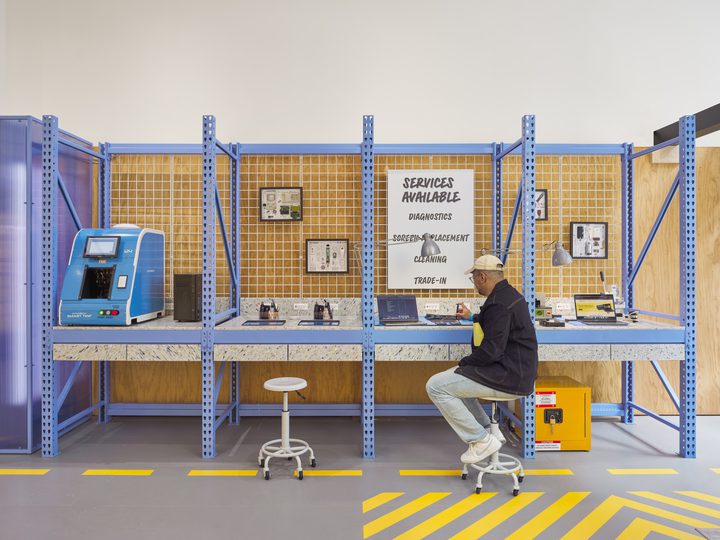
The SoHo store was purposefully designed with this messaging and ethos in mind, with service offerings like repairs, cleaning and opportunities to trade in old devices for cash placed front and center at the entrance.
“One screen is cracked in the U.S. every single minute,” said Benton. “You don’t need a new device, you just need a new screen, but repairs aren’t as accessible, easy or affordable as they should be in the U.S. We’re also cleaning devices so people can take care of what they have. It’s not really a speaker issue, there’s just some lint in there — that too is a really common issue. My phone isn’t charging that well, turns out it’s just dirty; we can repair that.”
Products are available for sale in the middle of the store, but the ultimate goal is not to sell products, illustrated by the fact that “there is no incentive that any of the team members working in this retail store have to sell,” said Benton. “It’s about building trust and awareness of Back Market and the quality standards that we have.”
A number of hands-on activations help drive this even further home, including a New vs. Refurbished display, where visitors are challenged to spot the difference between new and used devices, as well as a setup showcasing the various tests Back Market sellers run on devices to grade and price items before listing them on the marketplace.
The store also will feature Google Fi Wireless offerings, a mobile network operator that allows customers to use any unlocked phone, not just one provided by the network operator like at many other carriers.
Giving Consumers the Chance to Experience Refurbished Tech
The back of the store is dedicated to education, with videos and a curated selection of books. And the store will host a series of events throughout its three-month run to further illustrate its point, including:
- An upcoming panel that brings together the fast fashion and fast tech conversations;
- A workshop on upcycling old tech to create new products, inspired by Back Market’s recent collaboration with Canadian designer Gabbois;
- Trade-in events where consumers can get cash for old devices as well as donate those not fit for resale to be repurposed or recycled; and
- Repair clinics with partner iFixit to teach consumers how to fix their own devices.
“The Back Market SoHo store is about showing what’s possible,” said Thibaud Hug de Larauze, Co-founder and CEO of Back Market in a statement. “When people experience refurbished tech in person, they see the quality, the savings and the potential to live smarter. We believe this pilot can spark real trust and momentum for a more sustainable way forward.”
Looking Beyond Smart Devices to all Kinds of Tech
Another important point will be highlighting the refurbished opportunity for products beyond smartphones and laptops. “A lot of us have one phone, maybe two, but we don’t consider the number of kitchen appliances, your hair dryer, all these other things that contribute to that e-waste challenge,” said Benton, noting that all of these also are products that can be refurbished and are sold on Back Market today.
While the primary goal of the store isn’t sales, products will of course be offered for sale. A selection of the top-selling items on Back Market, primarily smartphones, will be available to buy on the spot, while a range of other items, such as a window air conditioner unit, are displayed with QR codes and can be ordered from BackMarket.com. Products also feature E Ink electronic price tags that will align pricing in real time with the prices on the Back Market marketplace, as well as explain how products are graded.
A stock ticker-style display, visible both outside and inside the store, shows the going price for top products. “I think it’s really engaging, even just to watch, because there really are fluctuations,” said Benton. “One seller that’s winning that Buy Box [on BackMarket.com] right now might sell out of their inventory, and so the prices start to change.”
BackMarket.com brings together offerings from 300 refurbishers, and Benton said the competition to win the Buy Box (that is, be the seller whose product will be offered to the customer) is fierce. That selection is based first on seller quality (based on Back Market’s own experience with the refurbisher and their products) and then on price.
Back Market’s Brick-and-Mortar Future
The SoHo store is a big initiative for Back Market, but it’s not clear yet whether it’s the beginning of a larger push into brick-and-mortar. “I have strong hopes that this is just the first step in what we could create from a physical perspective and speaking to our customers,” said Benton. “There are so many hypotheses about which direction this will go, so it will be really interesting to see where that demand is from customers.”
When asked if the store was a “flag in the ground” for Back Market as competitors like Ebay and PayMore pick up steam both online and IRL, Benton said not really.
“Across the country, we estimate that only about 5% of people are actually buying refurbished smartphones,” she said. “Right now there is still so much growth and opportunity that, as long as someone is actually delivering high-quality devices and not turning people off [by selling] lemons, I’m happy. My focus is getting people away from new and educating them around the quality of refurbished tech. What I want them to take away the store is that refurbished is a real, viable option.
“We’re also seeing a shift with Gen Z on our site,” Benton added. “About 60% of them are reporting buying refurbished for the first time. That’s what I want to drive up with the store — how many people are choosing to try refurbished for the first time and how many were nudged in that direction because they got to have that physical touch point to really build the trust.”




